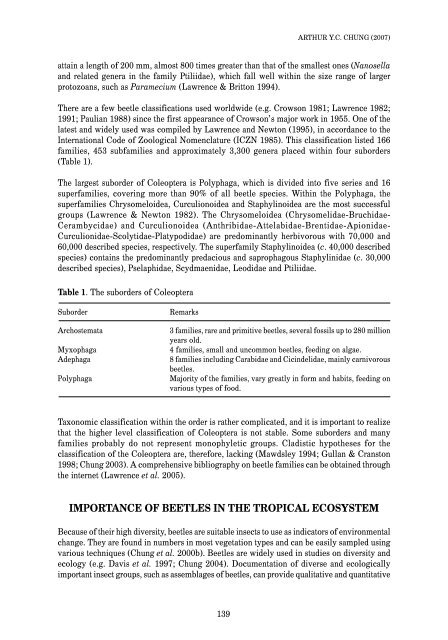o_19ko2dt161ng2j4e1tgnoqv1s45a.pdf
You also want an ePaper? Increase the reach of your titles
YUMPU automatically turns print PDFs into web optimized ePapers that Google loves.
ARTHUR Y.C. CHUNG (2007)<br />
attain a length of 200 mm, almost 800 times greater than that of the smallest ones (Nanosella<br />
and related genera in the family Ptiliidae), which fall well within the size range of larger<br />
protozoans, such as Paramecium (Lawrence & Britton 1994).<br />
There are a few beetle classifications used worldwide (e.g. Crowson 1981; Lawrence 1982;<br />
1991; Paulian 1988) since the first appearance of Crowson’s major work in 1955. One of the<br />
latest and widely used was compiled by Lawrence and Newton (1995), in accordance to the<br />
International Code of Zoological Nomenclature (ICZN 1985). This classification listed 166<br />
families, 453 subfamilies and approximately 3,300 genera placed within four suborders<br />
(Table 1).<br />
The largest suborder of Coleoptera is Polyphaga, which is divided into five series and 16<br />
superfamilies, covering more than 90% of all beetle species. Within the Polyphaga, the<br />
superfamilies Chrysomeloidea, Curculionoidea and Staphylinoidea are the most successful<br />
groups (Lawrence & Newton 1982). The Chrysomeloidea (Chrysomelidae-Bruchidae-<br />
Cerambycidae) and Curculionoidea (Anthribidae-Attelabidae-Brentidae-Apionidae-<br />
Curculionidae-Scolytidae-Platypodidae) are predominantly herbivorous with 70,000 and<br />
60,000 described species, respectively. The superfamily Staphylinoidea (c. 40,000 described<br />
species) contains the predominantly predacious and saprophagous Staphylinidae (c. 30,000<br />
described species), Pselaphidae, Scydmaenidae, Leodidae and Ptiliidae.<br />
Table 1. The suborders of Coleoptera<br />
Suborder<br />
Archostemata<br />
Myxophaga<br />
Adephaga<br />
Polyphaga<br />
Remarks<br />
3 families, rare and primitive beetles, several fossils up to 280 million<br />
years old.<br />
4 families, small and uncommon beetles, feeding on algae.<br />
8 families including Carabidae and Cicindelidae, mainly carnivorous<br />
beetles.<br />
Majority of the families, vary greatly in form and habits, feeding on<br />
various types of food.<br />
Taxonomic classification within the order is rather complicated, and it is important to realize<br />
that the higher level classification of Coleoptera is not stable. Some suborders and many<br />
families probably do not represent monophyletic groups. Cladistic hypotheses for the<br />
classification of the Coleoptera are, therefore, lacking (Mawdsley 1994; Gullan & Cranston<br />
1998; Chung 2003). A comprehensive bibliography on beetle families can be obtained through<br />
the internet (Lawrence et al. 2005).<br />
IMPORTANCE OF BEETLES IN THE TROPICAL ECOSYSTEM<br />
Because of their high diversity, beetles are suitable insects to use as indicators of environmental<br />
change. They are found in numbers in most vegetation types and can be easily sampled using<br />
various techniques (Chung et al. 2000b). Beetles are widely used in studies on diversity and<br />
ecology (e.g. Davis et al. 1997; Chung 2004). Documentation of diverse and ecologically<br />
important insect groups, such as assemblages of beetles, can provide qualitative and quantitative<br />
139



